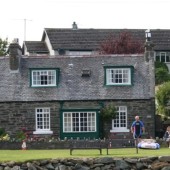Single Track Roads

The Highway Code, section 132:
Take extra care on country roads and reduce your speed at aproaches to bends, which can be sharper than they appear, and at minor junctions and turnings, which may be partially hidden. Be prepared for pedestrians, horse riders and cyclists walking or riding in the road. You should also reduce your speed where country roads enter villages.
Driving on country roads needs to be taken steadily, and drivers must be ready to stop at any time to avoid unexpected hazards. Roads can become narrow at old bridges and places where there are stone walls on both sides of the road. Give slower, non-motorised road users such as walkers, cyclists, horse riders and farm livestock or wild animals enough time and space to move either into a passing place or off the road. Pass wide and slowly.
The Highway Code, section 133:
Single-track roads. These roads are only wide enough for one vehicle. They have special passing places. If you see a vehicle coming towards you, or the driver behind wants to overtake, pull into a passing place on your left, or wait opposite a passing place on your right. Give way to vehicles coming uphill whenever you can. If necessary, reverse until you reach a passing place to let the other vehicle pass.
Many passing places are marked by black and white poles at the roadsides, but some passing places are not marked. Drivers using single-track roads must be able to reverse to a passing place in order to let other vehicles pass. Sometimes drivers must reverse more than a metre or two. Driving onto verges to avoid reversing is not recommended, as cars may be damaged or get stuck in roadside ditches. It is usual to give a friendly wave as ‘thank you’ if another road user has reversed or waited for you to pass. It makes all the difference!
The Highway Code, section 134:
Do not park in passing places. Parking your car in passing places to watch birds, photograph the scenery, or to leave your vehicle while you go for a walk, prevents other road users from using passing places. If your car blocks a passing place and stops other drivers, cyclists or horse-riders from allowing vehicles to move by, dangerous situations can occur. If you must stop in a passing place for a short time, be prepared to drive on immediately.
Parking in or near entrances to farm tracks, in field gateways or at cattle grid gates can prevent access by farmers and others who live and work in the countryside. 24-hour access to gates is often required, either by people whose homes are up farm tracks or by farmers who may need to move livestock or large farm machinery. It may not be easy to see that these access points are in regular use, but that is usually the case.








_baef36edc53bdd009ca06069d3b23fda.jpg)





